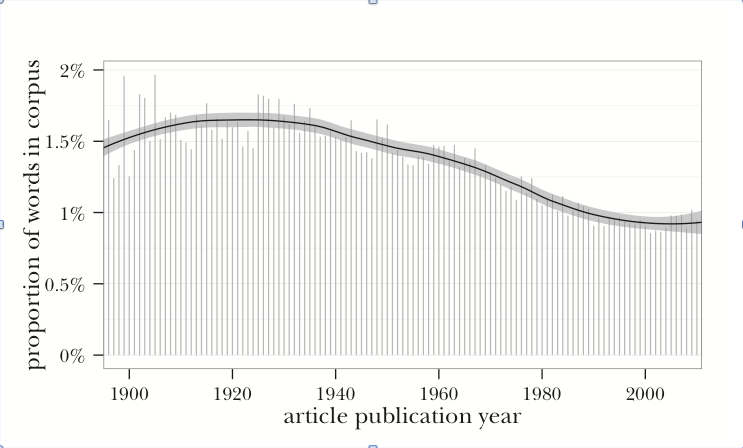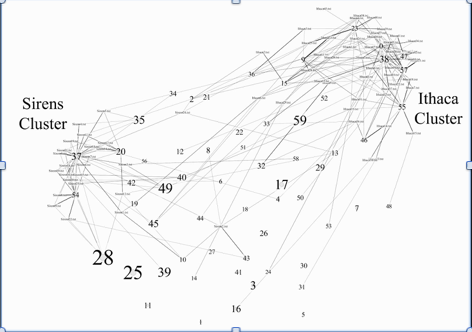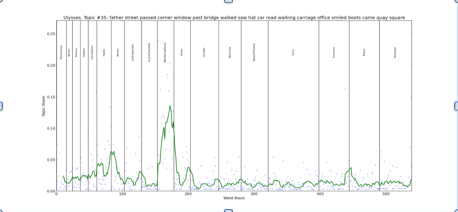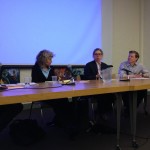
At the symposium “The Literary and Its Outsides” held at UC Berkeley on April 1, Representations editorial board members Kent Puckett and Stephen Best offered responses to the journal’s recent special issue “Denotatively, Technically, Literally.”
STEPHEN BEST | “Well, that was obvious.”
I would argue that the current period of disciplinary navel-gazing began in 2004, with the Critical Inquiry volume on the future of criticism that was organized to mark the journal’s 30th year of publication. Bruno Latour’s “Why Has Critique Run Out of Steam?,” in which he makes a number of observations regarding the impasses of critique in science studies, appears in that volume, and has since served as a touchstone for a generation of special issues on the limits of historicist “critique.” At Representations, in the fall of 2009, we published “The Way We Read Now,” a volume in which a number of the scholars assembled here today also participated. That volume identified methods of interpretation that depart from a long tradition of “symptomatic reading,” which understands texts as symptoms of hidden structural and psychic forces – from material histories of the book and “new formalisms” to sociologies of reading and data mining. In the introduction to that volume, Sharon Marcus and I offered the notion of “surface reading,” arguing that literary critics might productively locate meaning in what texts say rather than in what they do not, cannot, or will not say. One of the points of our introduction was to extend Latour’s observations to the domain of literary criticism, suggesting that the work of demystification, so central to Marxist, psychoanalytic, feminist, and New Historicist criticism of the 1980s and 1990s, loses much of its effectiveness in a moment when its moves can be anticipated. Heather Love’s “Close But Not Deep: Literary Ethics and the Descriptive Turn,” published in a 2010 special issue of New Literary History called “New Sociologies of Literature,” suggested that practices of description offered a useful alternative to depth hermeneutics, drawing for her method the accent on interactions and operations in the sociology of Latour as well as Erving Goffman. At least two special issues appeared in the last several months that I would consider a part of this moment of critical self-reflection. In the commemorative volume of American Literary History, entitled “History, Historicism, and Historiography,” a journal that had relentlessly scrutinized the categories American and literary since its inception has turned its attention toward the third category – history – which over that same time, in the thinking of at least one of the contributors, had been taken more in the Jamesonian sense of an “imperative.”[i] And, finally, the Victorian Studies volume “The Ends of History” responds to these calls for alternatives to historicist “critique,” setting forth a range of practices that aim to reshape the historicisms of the past.
Cathy Gallagher, in the “Afterword” to the Victorian Studies volume, observes that all this controversy “sounds like an echo chamber for almost every debate regarding historical criticism that has emerged since the 1950s.”[ii] Thus when Love asserts that “deep” reading and textual “richness” serve as carriers for “an allegedly superannuated humanism,” she echoes Althusserian critics’ accusations that Raymond Williams merely propped up bourgeois humanism.[iii] Or when anti-critique critics assert their hostility to ideology, they are merely grafting their ideas onto Foucauldian roots that had been crucial to the New Historicists, where power “denied that texts (and discourses) were pathological,” and as such both devoid of symptoms and incapable of generating symptomatic readings (Gallagher 686). Each one of the contributions to the Victorian Studies volume, she writes, “reverberates with a unique arrangement of echoing judgments,” and in that respect, like the broader debate to which the volume contributes, rings “familiar rather than unique to the current critical moment” (683-4). We’re not dealing with our issues in these special issues — that seems to be the conclusion.
But ten years of special issues sure seems like a lot of anxious worrying about the future of criticism and the limits of historicism, certainly more than can be reduced to an “echo” of a previous generation’s terms of debate. I understand that, in this circumstance, I might be expected to issue a resounding “no” to this charge – to deny the claim that the terms of recent literary critical debate simply rehash those of an earlier one. Still, I’d prefer to inhabit the charge, and argue that we ought to find interesting the reasons behind the echoes and repetitions.
The current issue of Representations (“Denotatively, Technically, Literally”) hones in on some of the concerns regarding literality that were raised in “The Way We Read Now,” taking up, in particular, language that, as literary critics, we often leave unread, “as if it were denotative, literal, and technical,” as Freedgood and Schmitt write (1). When we read so as to concede that language “either means what it says or stands outside our purview,” they continue, “we create or recreate these categories of language within the literary, lightening our work but also thinning texts to predetermined sites of meaning or interpretive possibility . . . . To read denotatively, technically, or literally is not to explicate . . . . It is the reverse: to restore obscurity to the apparently clear, to stop language from working” (1). What if we pitched Gallagher suspicions at this description of denotative reading: does this way of configuring denotative reading echo judgments about literary language formed by a prior literary critical generation? By folding denotation into the act of literary reading, does it not bear a familiar ring with Paul de Man’s judgment of the literary as the kind of writing uniquely aware of the instability of the distinction between the literal and the figurative, between grammatical and rhetorical modes of meaning? And by offering “nonfigurative reading” as one way of approaching the text, are the editors simply coming at the literary from the opposite side to de Man’s “rhetorical reading” – denotative reading and rhetorical reading sharing a basic premise, i.e., the idea that “we organize – [that is] stabilize – language as we read it,” specifically the instability between the literal and the figurative?[iv] When de Man notes that the irony of the literary text is that it “says one thing and performs another,” couldn’t that apply to its denotative aspect as well if to read denotatively, technically, or literally, again, “is not to explicate . . . [but] to restore obscurity to the apparently clear” (4)? And when he claims that a text “simultaneously asserts and denies the authority of its own rhetorical mode,” isn’t that precisely what the editors have here claimed for its denotative mode?[v] All that said, and accepting the link back to de Man for the sake of argument, should it be a problem that “denotative reading” echoes “rhetorical reading” when the former proves so phenomenally productive: giving us more to read, as the editors put it, that is, directing our attention to the “understudied languages of the novel” (3), the stuff we’ve ruled out, ignored, deemed opaque, or passed by?
In Louis Menand’s recent review of the Evelyn Barish biography, he observes that the de Manian project of bracketing off the “real-life aspects of literature” – that it’s written by people, that it affects people – the putting aside of these aspects allowed for a more purposeful burrowing into the way literary language works. Menand celebrates this way of reading as de Man’s attempt to (as he puts it) “get inside the atom.” What if denotative reading doesn’t alter the fact of that burrowing, but simply shifts the terms a bit, from rhetoric and figurality to literality, denotation, reference and description? What we might lose in that case is precisely the configuration “the literary and its outsides” — some requirement that one must jettison denotative or literal language beyond the pale of critical scrutiny in order to preserve the distinctiveness of literature. What we might stand to gain is a sense of another generation of literary critics’ attempting to “get inside the atom.” To come at it another way, as Kent put it to me in another context, rather than ask whether something is a description or an interpretation, a text’s surface or its depths, what the text says or what it means, a denotation or a connotation, rather than make “dualist” distinctions, perhaps we ought to be ask what is currently drawing our attention to description?, what is currently drawing our attention to denotation? The answer might be something like the urgency of coming to terms with the nature of things. The interest in description, the interest in denotation: both reflect an anti-dialectical or post-dialectical turn in recent critical theory, and share the “monist” impulses of other critical tendencies:
-
- the Deleuzian fold
- Eve Sedgwick’s “cybernetic fold” (“differentiable but not originally differentiated system”)
- Graham Harman and Quentin Meillasoux’s Object-oriented Ontology
- David Graeber’s claims for debt as what gives market economies their “sense,” which shifts arguments regarding capitalism’s move into its late stage away from the commodity (it’s mystery, the symptom, the movement of the dialectic)
- the resurgent interest in Wittgenstein, and specifically his invitation to see the object represented in language not as something that means this or that, but as having multiple aspects, a bundle or sheaf of aspects (see especially Michael Taussig on apotropaic texts and Ross Posnock on W.G. Sebald)
There look to me to be monist impulses in Roland Barthes’s “return of literality,” which Rachel Buurma and Laura Heffernan attribute to his turn away from the “metalanguage” of critique and toward that sense of “notation” necessary to begin thinking about the writing of a novel: Barthes’s attempt to (in his words) “guid[e] the work toward the presence of the world, making the world co-present to the Work.”[vi] This turn Barthes achieved over the course of the ten years separating “The Reality Effect” (published 1968) from his lecture course “The Preparation of the Novel” (which he began to teach at the Collège de France in 1978). Barthes bemoaned the way the earlier essay unwittingly replicated the distinction between the meaningful and the living (the meaningful and the meaningless) in the very act of critiquing it. The critic distrusts the evidence of the senses and experience: the problem for Barthes (in “The Reality Effect”), as Buurma and Heffernan’s phrase it, is that “what at first seems to be referential meaning turns out to be ideologically laden meaning designed to produce the effect of a meaningless, found world whose ‘resistance to meaning’ lies apart from language and signification.”[vii] A meaningless, found world: our distrust of experience is a product of ideology critique, and the critic’s metalanguage is what fuels that distrust. In place of the critic, Barthes substitutes the note taker who knows “that there is no life that is not already meaningful,” and that he or she “is already living in a fully meaningful world already, and knows this in a way that does not necessarily hurt, does not necessarily entail an enormous loss” (84-5). But such hard-won knowledge isn’t to be arrived at immediately; it is only available in the form of a “return to literality.” Barthes’s literality, Freedgood and Schmitt remind us, “is not the beginning but ‘the end of a journey’” (Freedgood/Schmitt, 5). This is why Barthes designates it “literal II.” From The Preparation of the Novel: “In order to reach the third state, the literal II, or the return of the literal, you first have to pass through interpretation . . . . The first literality: an arrogance [is not equal to] the second: a ‘wisdom’” (Barthes, 81). In order to “reach the third state,” Barthes had to abandon the identity of critic, had to put “a stop to the division of the subject,” and take on the mantle of novelist.
Barthes’s “return of the literal” sounds an awful lot like some descriptions of the obvious that I’ve happened upon as I’ve worked on Benito Cereno; descriptions that seem less intent to classify the obvious, or define it, and more keen to temporize it as an irreducible aspect of reading. Here is one example that appears in A. S. Byatt’s Possession, she writes: “the knowledge that we shall know the writing differently or better or satisfactorily runs ahead of any capacity to say what we know, or how. In these readings, a sense that the text has appeared to be wholly new, never before seen, is followed, almost immediately, by the sense that it was always there, that we, the readers, knew it was always there, and have always known it was as it was, though we have now for the first time recognized, become fully cognizant of, our knowledge.”[viii] Now, any critical position worth its salt will almost always finally rest upon calling certain other claims obvious and thus to be ruled out, ignored, passed over.[ix] The trivialization of the obvious in literary criticism feels almost like an inaugurating gesture. The obvious is something, as Stanley Cavell has put it, “which for some reason is always underestimated, habitually . . . by critics, even when the art which hosts [it] is devoted to [its] seeing, and the artist set against that underestimation” (82). What criticism trivializes, novelists valorize (even one who, like Barthes, simply hoped to be a novelist). But what interests me are not these attempts to host the obvious, but this desire to “pass through interpretation” on one’s way back to the literal or the obvious; this desire to make the obvious or easily available not something superficial, but an achievement, something that requires critical work.
Let me close with a gesture toward another field of inquiry: the philosophy of perception. I think that it is here, in particular, in the work of philosophers who reject what is called the “myth of the given,” that we find a parallel means for working out the claim that it can be an achievement and require work to see what’s right in front of you. I have in mind the argument, say in John McDowell’s Mind and World, that even though perception allows us passive access to knowledge of the world, we wouldn’t be able to have such access unless we also had certain rational capacities in the background that we needed to be trained into. McDowell has no philosophical use for an idea that our experience contains representations that are not conceptually structured, that one has access to a genuinely passive perception. It is possible that the concepts of surface reading or denotative reading do not lend themselves to this type of analysis, but there does seem to be some consensus for the view that it can require work to see what’s right in front of you; or, to give Freedgood and Schmitt the final word (and go ahead, hear a bit of Neil Sedaka when I read them, a bit of melancholy for that old flame, rhetorical reading): “literal reading . . . is hard to do.” (9).
[i] Jennifer Fleissner, “Historicism Blues,” American Literary History, vol. 25, no. 4 (Winter 2013): 1-19.
[ii] Catherine Gallagher, “The Ends of History: Afterword,” Victorian Studies (Summer 2013): 683.
[iii] Heather Love, “Close But Not Deep: Literary Ethics and the Descriptive Turn,” New Literary History vol. 41, no. 2 (Spring 2010): 371-391.
[iv] Louis Menand, “The de Man Case,” The New Yorker, 24 March 2014
[v] Paul de Man, Allegories of Reading (1979), p.17
[vi] Roland Barthes, The Preparation of the Novel, trans. Kate Briggs (New York: Columbia University Press, 2011), 205.
[vii] Rachel Sagner Buurma and Laura Heffernan, “Notation After ‘The Reality Effect’: Remaking Reference with Roland Barthes and Sheila Heti,” Representations 125, Winter 2014: 80-102, 84.
[viii] Antonia S. Byatt, Possession; quoted in Morrison, Playing in the Dark: Whiteness and the Literary Imagination (New York: Vintage Books, 1992), xi-xii.
[ix] Stanley Cavell, “The Avoidance of Love: A Reading of King Lear,” in Disclaiming Knowledge (Cambridge: Cambridge University Press, 1987), 82-4.
KENT PUCKETT | Response
This special issue of Representations is an important contribution to a larger conversation happening in the humanities today. What do we want or expect from interpretation? Should we read for meaning, for significance, for depth, for connotation, or is it time to read for something else?
We need, however, to ask: are these methodological or historical questions? Or are they methodological questions that contain or conceal an idea about history? Or are they historical questions that must for some reason take the form of methodology?
The age of interpretation, of suspicion, of the symptom is the age of Freud and Marx, of the unconscious and ideology, and a consensus seems to be emerging that those models have somehow outlived their usefulness. What, though, do we think about Marx and Freud, about ideology and the unconscious when we imagine them as having passed their respective dates of expiration?
If we take it that these models demand interpretation because they rely on “vulgar” oppositions between consciousness and the unconscious, base and superstructure, surface and depth, connotation and denotation, then good riddance.
It seems to me, though, that both Marx and Freud are more subtle than that (surprise!). In both cases, interpretation is a response to relations between things, and, indeed, it is the fungibility of relations that demands and enlivens the act of interpretation. When we interpret the dream (something analogous could be said about the commodity), we’re not exposing the unconscious, we’re rather exploring a vital relation between things, between latent and manifest contents as well as between the past and the present, inside and outside, the pleasure principle and what lies beyond.
As everyone knows, the content of and explanations for dreams are boring. Relations, on the other hand, are always interesting. This is why the object of Freudian dream analysis is not the dream but the dreamwork, the processes of condensation and displacement that sit between two contents that were always sort of obvious to begin with.
Rather than think of interpretation as a final revelation of what’s behind the dream or the symptom, psychoanalysis—at its best and it’s, of course, not always at its best—is an invitation to remain in the space of that relation. This is why Freud imagines the dream as having a navel, why he requires threshold concepts like secondary revision and deferred action, and why, finally, he sees psychoanalysis as interminable.
Barthes makes a similar case in Writing Degree Zero and S/Z. In his effort to identify the literary, he draws on the terms of structural linguistics and imagines two poles of significance that bracket literary writing. On the one hand, there’s the pole of pure style: “it is the writer’s ‘thing,’ his glory and his prison, it is his solitude.”[1] This is parole without langue, a private writing that is so personal, so raw that it must be incomprehensible to others. On the other hand, there is what he calls language: “a language is a kind of natural ambience wholly pervading the writer’s expression, yet without endowing it with form or content.” This is langue without parole, the storehouse of conventions out of which the writer selects his or her already cooked materials.
We might think of both these poles as being only available to denotation; they can be named, which is to say repeated, but not explained or interpreted. When faced with either style or language, the magic word or the phone book, the imaginary or the symbolic, all one can really do is point because neither style nor language can ever on their own be like anything else. Because literary writing exists somewhere on the line that links these poles, and because denotative limits make that continuum possible, it represents a point where, like the space between the manifest and latent content of the dream, denotation passes into connotation and connotation into denotation.
The literary happens, perhaps, when we can’t tell the difference. This is, I think, what Genette calls “the paradox of every poetics”: “always torn between those two unavoidable commonplaces—that there are no objects except particular ones and no science except of the general—but always finding comfort and something like attraction in this other, slightly less widespread truth, that the general is at the heart of the particular, and therefore (contrary to the common preconception) the knowable is at the heart of the mysterious.”[2]
This is why instead of saying that we need to choose between denotation and connotation, Barthes says in S/Z that denotation is always only the place where connotation comes to a provisional halt; they are, he says, only “supposedly different systems.”[3] This is not to deny the reality of denotation; as Barthes understands, denotation is a real aspect of language. It is, as Jakobson said before him, one and only one of its several functions. Literary reading is, in that case, always suspended between denotation and connotation; it is the recognition that literature is meaningful not because it is surface or depth, denotation or connotation, but rather because it is a protean point of suspension between the two.
So, from a methodological point of view, the recovery of denotation as a term of art is crucial because it helps us to avoid arguments that emerge from reifying differences that are projected as metaphors onto an account of language that we should understand not in terms of seeing oppositions but, rather and following Wittgenstein, seeing aspects. Language has different functions, different aspects and literature happens when some or all of those functions are held in a certain kind of suspension. To assert these differences as ontologically as opposed to heuristically real, or in fact to read Barthes or Freud or Genette as asserting them as ontologically as opposed to heuristically real is to miss the point.
The essays in this volume help us to see that moment of suspension between connotation and denotation in several different expressions: in the space between belief and disbelief conjured by the Victorian ghost; in the space between invention and discovery, induction and deduction in Victorian science; in the space between the personal impersonality of technical maturity and the impersonal personality of the classic bildungsroman; and the space between known of literary convention and the unknown of early subaquatic discovery.
What these examples also share is a rough time period, one that coincides with the kind of interpretive suspension that I’ve been describing.
A historical question thus remains: do denotation and its interpretive demands work in the same way at other moments in time?
This is the question that seems to motivate some recent turns away from interpretation toward surfaces, toward new ontologies, toward the assemblage. Implied here is the idea that something has changed that demands a new way of seeing meaning. Have materialist discoveries about the brain mooted talk of the unconscious? Has a widening sense of ecological precarity undermined the urgency of the phenomenological? Has the financialization of the culture industry undone a historically specific alienation that underwrote the antinomies of bourgeois thought and the critical theories that went along with them?
There’s obviously too much to say here. I want, though, to suggest that these essays begin to imagine a politics of denotation and thus of interpretation that we need carefully to consider. It’s there in Cannon Schmitt’s invitation for us to look differently at the work, the labor of the novel, in Margaret Cohen’s suggestion that we consider what happens when there are no coral reefs left to denote, in Ian Duncan’s discussion of the passage between the figural and and the empirical that authorizes science, in Elaine Freedgood’s suggestion that ghosts not only allow us to diagnosis a moment’s relation to belief but also to follow the traces of its political disavowals: ghosts “always return: as farce, as tragedy, as religion, and as an exercise in choosing what to believe, and more radically perhaps, what to see.”
Indeed, Freedgood’s essay—and the whole of the issue—made me think of another example. In 1919 Abel Gance made a film called J’accuse. It’s a silent antiwar melodrama that follows the experience of two soldiers who love the same woman during the First World War. One dies and the other goes mad with shell shock. At the film’s end, the latter returns home, wild-eyed and apparently paranoid, to tell the people of his town that he’s seen the ghosts of the war dead rise from their graves. Before he finishes, the war dead appear for all to see and march through the town, accusing those who betrayed the war dead and saying goodbye to the faithful. Gance handles the moment with remarkable restraint, using montage and subtle, ghostly transparencies to create a believable encounter between the living and the dead. The gesture is also a moment of political denotation: Gance uses the sequence to point at what’s hard to point at, the whole human costs and consequences of war. To accuse, for Gance, is to try and denote cinematically, which is also to demand that his audience interpret.
In 1938, Gance remakes the film as a sound feature; it is once again called J’accuse. Where the earlier version was a response to a war that had just ended, the later version is made on the eve of another war, a war that seems to depend on our having forgot the suffering and stupidity of what came before. He also restages the earlier film’s ultimate appearance of the dead. Where in the first film he relies on montage, in 1938 he uses lurid anamorphic lens effects to suggest the breakdown between the worlds of the living and the dead. And as opposed to the quiet, if chilling confrontation between dead soldiers and survivors, he films the sequence as if it were a horror film. The townspeople run, scream, and riot as if the soldiers were Romero zombies as opposed to Shakespeare’s ghosts. And instead of actors, Gance uses real veterans from the First World War, soldiers whose faces were mutilated or, as they said, “broken” in an apparent attempt to bypass the merely believable in order to show us the real. This, too, is an act of denotation, a fantastic effort to name directly and not merely to imply or to figure the costs of war.
So, we have two moments of denotation that share the same subject (war in all its complexity), the same narrative context (the story of two soldiers), the same historical object (WWI), and the same director (Abel Gance). They are, though, entirely different. What, then, has changed? I want to say that denotation has changed; the basic coordinates of aboutness, of denotation, of connotation have changed. Gance demands something different from denotation after one war and before another and so allows us to track a passage in the related histories of war, belief, and reference. Because denotation has a history, turning to it is necessarily not to turn away from either interpretation or critique. So, while there’s much more to say here, I’ll end by suggesting that what Gance and these essays have to tell us is that there’s critical life in denotation, connotation, and interpretation still yet. We don’t have necessarily to give up the ghost.
[1] Roland Barthes, Writing Degree Zero (Macmillan, 1977) 11.
[2] Gerard Genette, Narrative Discourse: An Essay in Method (Ithaca: Cornell University Press, 1983) 23.
[3] Barthes, S/Z: An Essay (Macmillan, 1975) 9.
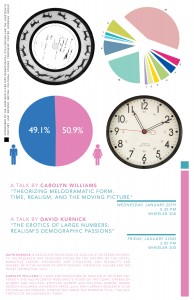 David Kurnick, Associate Professor of English at Rutgers University, will present a talk at UC Berkeley entitled “The Erotics of Large Numbers: Realism’s Demographic Passions.“ The event will take place on Friday, January 22nd at 3:00pm in 300 Wheeler Hall.
David Kurnick, Associate Professor of English at Rutgers University, will present a talk at UC Berkeley entitled “The Erotics of Large Numbers: Realism’s Demographic Passions.“ The event will take place on Friday, January 22nd at 3:00pm in 300 Wheeler Hall.
